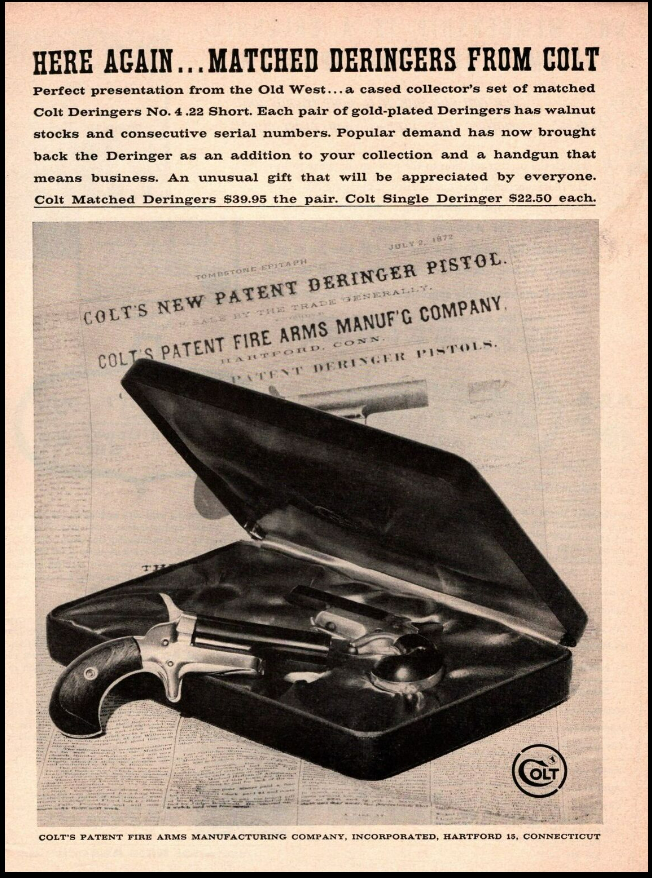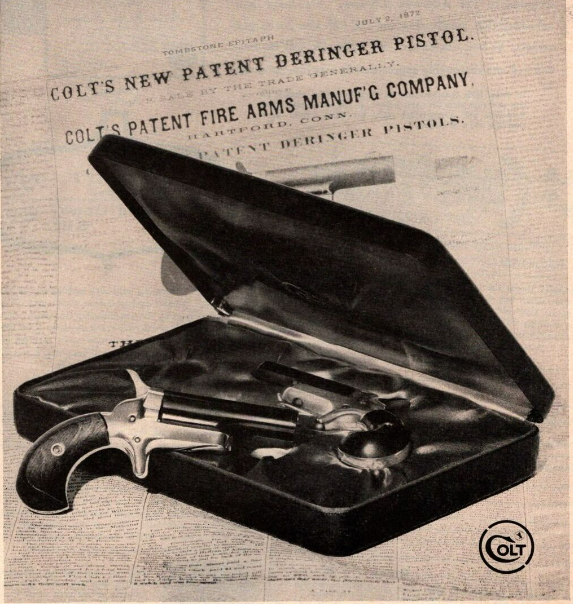This Classic Colt Derringer Manages to Keep Shooting for Over 60 Years
I grew up in the 1950s. Cowboy movies and television shows reigned supreme. My father, a survivor of World War II, had a love for guns that I, naturally, inherited. Although well-fed, housed, and clothed, there wasn’t a lot of disposable income available to the Lofgren household during those somewhat lean but happy formative years. My dad started accumulating a few firearms during this time period. He was happiest when pistol plinking, hunting deer, or busting a few clays. Long before I was old enough to participate, I was always included in these outings and wouldn’t have wanted to be in any other place or with any other person.
It became a ritual, beginning sometime around 1960 or so, when my sister and I were old enough for my mother to go to work and provide some extra income, for my father to receive a special Christmas gift under the tree each year. The guns were initially selected for him by my mother but later purchased with my input. It was always a gun of some sort, and my father was always elated with whatever it turned out to be. On his passing, he still had every one of those guns. In 1960, he received a set of Colt No. 4 derringers.
1870: The First Era of Colt Derringers
In 1870, Colt produced its first single-shot pistol to answer the call for a small, easy-to-conceal firearm. A firearm that could be tucked into a gentleman’s vest pocket or discreetly hidden away in a lady’s bodice or garter belt. It utilized a barrel that pivoted sideways for loading and was chambered for the rather anemic .41 Colt Rimfire cartridge. It morphed through three model changes during its 32-year production run, with the last model being offered in 1912. The third model, redesigned by Alexander Thuer, who had designed Colt’s first metallic cartridge conversion, had a production run of some 48,000 guns. It came with a 2½-inch barrel that was either blued to contrast a bronze frame or silver/nickel-plated. Originals today are quite pricey.
Advertisement — Continue Reading Below

1959: The Birth of the Colt No.4
It wouldn’t be until 1959 that Colt again offered another derringer for the shooting public. Based on the third or Thuer model, Colt called the reissue of this derringer the “No. 4,” although “Colt’s P.F.A. Mfg. Co., Inc.” was inscribed on the left side of the barrel, these guns were actually made for Colt by a company called Butler of New Haven, Connecticut
During the No. 4’s four-year production run, Colt commissioned somewhere in the neighborhood of 137,000 examples. They were offering them as single guns, some mounted in picture frames or bookends, with a few limited-edition pairs offered housed in red-velvet-lined books. This is what my mom gave my dad on Christmas Day of 1960. Pop’s derringers had consecutive 204N and 205N serial numbers, indicating an early issued set.
Advertisement — Continue Reading Below
I discovered that Butler had fabricated these little pistols out of a very soft zinc alloy called “Zamak.” And although some sources say real early guns had a steel barrel liner (I could not successfully confirm this), most did not, including my dad’s pair. They were chambered in .22 Short, with the limited-edition pair featuring nickel plating and “plasticized” faux-ivory grips. Most sources related that even though chambered for the lowly .22 Short, minimal firing would strip the rifling out of these little derringers in short order.
The End of an Era
Pop’s philosophy (and subsequently my own) dictated that a gun was not a gun if you couldn’t shoot it. So each Fourth of July until I left home, Pop brought out the derringers and we fired a salute to our freedom in our backyard. After discovering the softness of the alloy used in the manufacture of the Butlers, I pulled them from my safe to examine their bores. Fortunately, they both still feature rifling, but I doubt I’ll fire them much more, lest they turn into smoothbores.
For years the little Colt No. 4s rested inside their protective book, hiding in plain sight in the bookcase in my parents’ home. That, unfortunately, took its toll on the book, which has flaked away in places and pulled away from its binding. One of its inner satin-lined panels now flaps free, but the pair still resides securely in their recesses. Both guns show a few scratches, and their grips have a few nicks and dents, so their current value is relatively low. These guns never did garner much of a following, and after Colt discontinued their production, Butler continued to offer similar guns in a variety of finishes until sometime into the early 1980s. The total production of these later guns is unknown.
Advertisement — Continue Reading Below
Still Shootin’
For the sake of this article, I popped a CCI .22 Short solid from each gun at a silhouette target placed at an across-the-card-table distance of about 5 feet. Both guns performed admirably, and the rifling remained intact when done. A single round fired from each piece across the screens of my chronograph revealed that serial number 204N was pushing its 29-grain projectile at around 509 fps at its muzzle while its partner, 205N, bested that velocity by another 30 fps or so. Like the anemic chambering found in its progenitor, I wouldn’t want to get shot with even the diminutive .22 Short, so I guess you could consider these Colts personal protection pieces.
Specifications: Colt No. 4 Derringer
Caliber: .22 Short
Barrel: 2½ inches
OA Length: 4½ inches
Weight: 8 ounces (empty)
Grips: Faux ivory
Sights: Fixed
Action: SA
Finish: Nickel
Capacity: Single-shot
MSRP: N/A
























